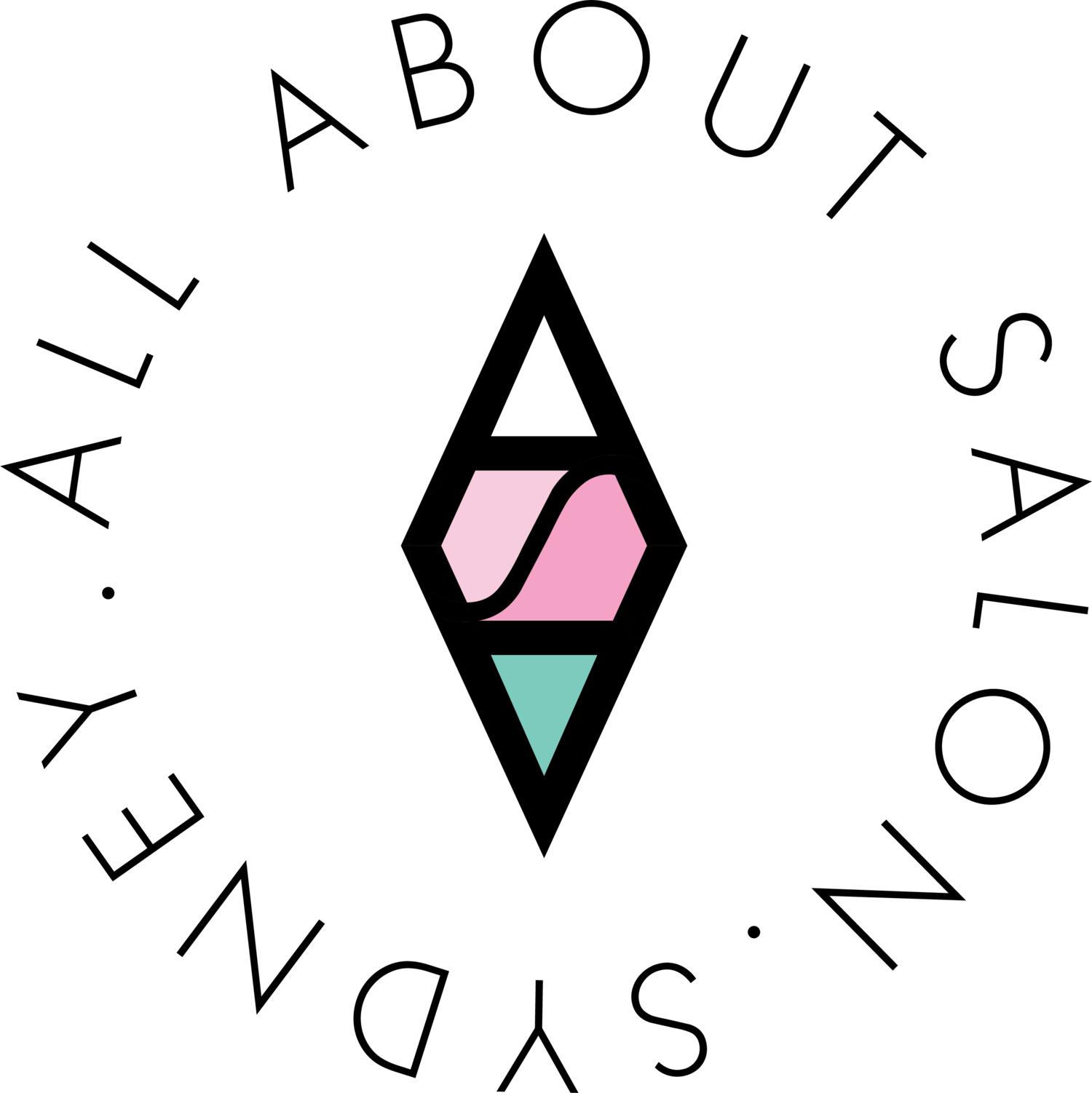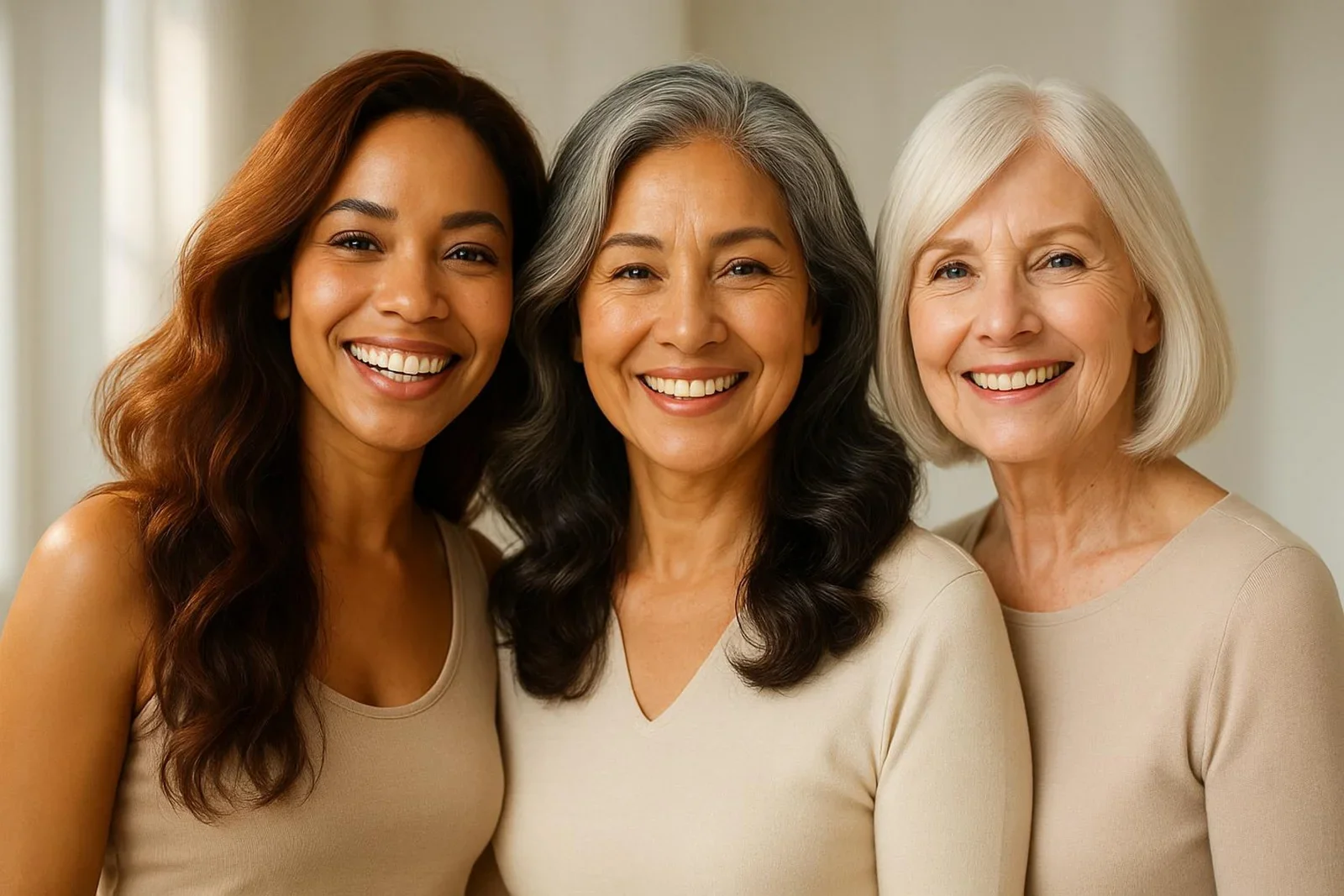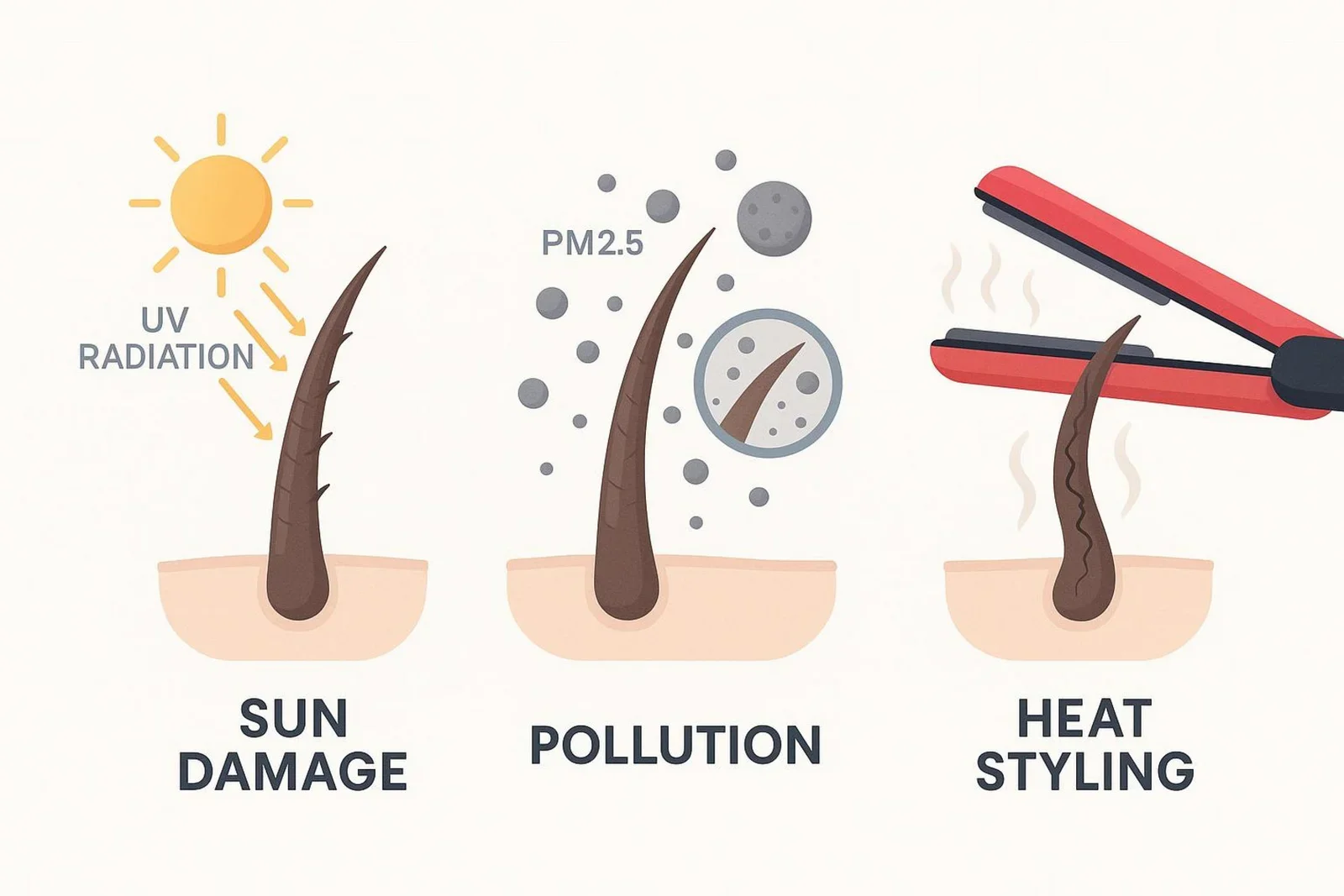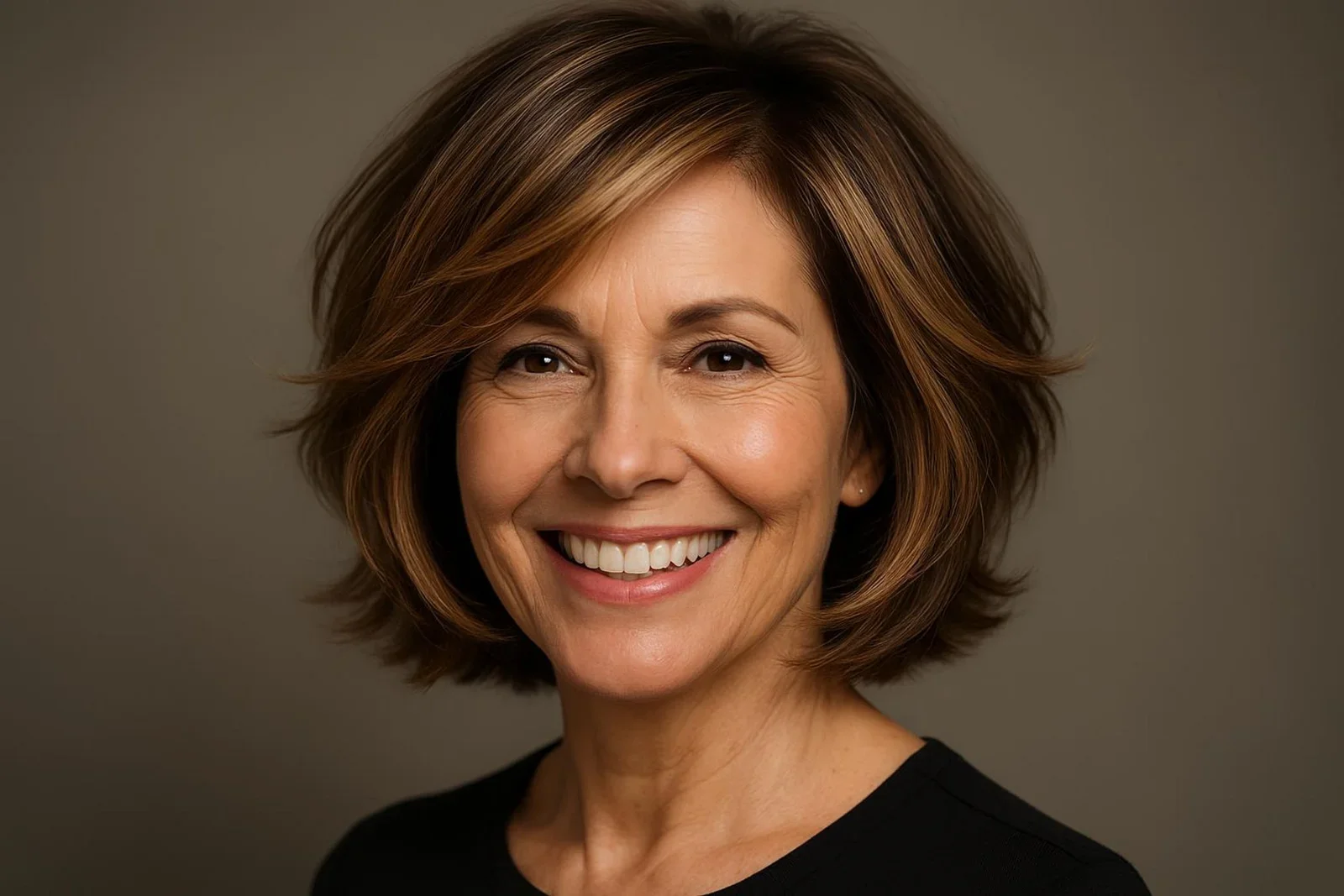Turn Back Time: Anti-Ageing Hair Care That Actually Works
Want your hair to look younger for longer? Good news: anti-ageing hair care can help. Hair and scalp change with age, much like skin. With the right mix of focused products, simple daily habits, and solid science, you can keep hair looking lively and strong. This is about staying ahead with smart care so your hair looks great at every age.
For years, beauty talk centred on skin while hair was left out. That’s changing. Hair has its own ageing process and needs steady, age-smart care. We can’t turn back time, but we can keep strength, bounce, and shine. Let’s look at what age does to hair and scalp-and how to handle it well.
What does ageing do to hair and scalp?
As the years pass, both hair and scalp shift. It’s more than just greys. Texture, thickness, and scalp balance all move in new directions. Knowing these shifts helps you build a routine that works.
Key changes in hair texture, thickness and colour
Texture: Hair often gets more porous. That means more frizz, dryness, and a rougher feel. Porous hair breaks more easily.
Thickness and volume: Follicles can shrink with age, so strands get finer and volume drops. Debra Lin, Ph.D., notes that ageing hair shows more shedding, slower growth, and less body.
Colour: Melanocytes (pigment cells) slow down, so melanin drops and grey/white hairs appear. It’s a visible sign of follicle ageing.
Common scalp concerns as you age
The scalp is the base of healthy hair. It also changes over time. Trichologist Bridgitte Hill explains the scalp shifts like facial skin does.
Less sebum: Hormonal changes (often 45-55) reduce oil production, leading to a dry scalp and brittle strands.
Dryness symptoms: Tightness, itch, and flakes can show up and make growth harder.
Weaker follicles: Skipping scalp care may lead to declining follicle health. Keeping the scalp barrier and microbiome balanced supports better growth and less hair loss.
When does hair start to show signs of ageing?
Many notice changes in their mid-30s-extra shedding, less bounce, or early greys. Shifts often speed up around perimenopause and menopause, with more thinning, dryness, dullness, and less elasticity. These changes build slowly, so starting early with smart care helps you stay ahead rather than chasing fixes later.
What lifestyle factors accelerate or prevent hair ageing?
Genes matter, but daily habits matter a lot too. What touches your hair, the air around you, how you eat, and how you style all add up.
Impact of sun, pollution and heat styling
Sun: UV weakens the shaft and fades colour.
Pollution: Particles cling to hair and scalp, causing dullness and dryness and may bother follicles.
Heat tools: Frequent high heat harms fragile strands and boosts breakage, especially with less natural oil. Cut back on heat and use a protector every time.
Does diet or supplementation influence hair health?
Yes. Hair reflects inner health. A balanced diet fuels growth. Protein and iron are key. Francesca Fusco, MD, says protein and iron top the list for healthy hair. Deficiencies can cause shedding and weak strands.
Supplements can help fill gaps. Nutrients linked to stronger hair include iron, zinc, vitamin C, B vitamins, and omega-3s. Hair scientist Gaby Longsworth, Ph.D., suggests a daily multivitamin and collagen, since collagen drops by the mid-50s. Products like Nutrafol (with zinc and antioxidants) may help once other issues are ruled out by a doctor.
Are silk pillowcases and gentle brushes worth it?
For sleep, silk pillowcases reduce friction that causes frizz, breakage, and snagging. Hair slides instead of catching, so you wake up with smoother, less tangled hair.
Use gentle tools too. You don’t need 100 strokes, but light brushing helps blood flow and moves natural oils down the shaft. Nunzio Saviano recommends a soft boar bristle brush (like Mason Pearson) to glide through delicate strands and spread oils without harm.
Which anti-ageing hair care ingredients deliver results?
Hair care now borrows smart ideas from skincare. Certain actives strengthen fibres, shield from stress, and support a healthy scalp.
Proven actives for hair strength and density
Proteins and peptides help rebuild weak fibres. Since hair is mostly keratin, adding keratin and small proteins (peptides) supports structure and cuts breakage. Hydrolysed keratin, collagen, and silk proteins are common. HairShots’ Thinning Peptides target shedding and thinning, and Keratin Bond Repair uses a peptide to reinforce from the inside.
For hair loss, two FDA-approved options exist: Minoxidil and Finasteride. Minoxidil boosts blood flow to follicles and can thicken shafts. Finasteride reduces DHT, which shrinks follicles. These are stronger options for bigger concerns and often need guidance from a professional. Natural options like rosemary oil have shown promise and, in some studies, performed similarly to minoxidil with fewer side effects. Tea tree oil may help scalp health too.
| Ingredient | Main role | Good for |
|---|---|---|
| Peptides/Proteins (keratin, collagen, silk) | Rebuild and strengthen fibres | Breakage, weak strands |
| Minoxidil | Supports growth, thicker shafts | Shedding, thinning |
| Finasteride | Lowers DHT | Male-pattern and some female hair loss (with medical advice) |
| Rosemary oil | Follicle support | Density, scalp health |
Hero hydrating and nourishing ingredients
Ageing hair often needs extra moisture and slip.
Ceramides: Seal the cuticle, lock in moisture, smooth frizz, and boost resilience.
Hyaluronic acid: Draws water to hair and scalp for steady hydration.
Vitamin E and light oils (like macadamia): Add softness and guard against damage.
Kérastase Chronologiste blends hyaluronic acid, vitamin E, ceramides, proteins, and peptides to refresh tired, fragile hair.
What to look for on product labels
Reading labels gets easier with a checklist:
Claims that fit “slow ageing” care: supports hair over time, builds strength, protects from UV/pollution, helps density.
Key actives: peptides/proteins (hydrolysed keratin, collagen, silk), ceramides, hyaluronic acid, antioxidants (vitamin C, vitamin E, green tea).
Scalp helpers: zinc pyrithione can calm and hydrate, even without dandruff.
Avoid harsh sulfates, which dry out porous or grey hair and can worsen yellowing.
Choose brands that share full ingredient lists and rely on science-backed formulas with safe, clean inputs.
How does routine impact ageing hair?
Daily habits shape how hair looks and feels. The right routine can reduce dryness, breakage, and dullness.
Choosing the right shampoo and conditioner for mature hair
Pick gentle, hydrating shampoos, ideally sulfate-free, to avoid stripping oils. Longsworth warns that sulfates can increase frizz, dryness, and yellow tones in grey hair.
Use conditioners that hydrate without weighing hair down. Look for ceramides, hyaluronic acid, and lightweight oils. Ranges like Aveda Invati (Exfoliating Shampoo, Thickening Intensive Conditioner) and L’Oreal Paris Elvive Volume Collagen (Texturising Shampoo and Conditioner) aim to add body and bounce while keeping hair smooth.
Should you use hair masks and treatments?
Yes. Masks and focused treatments give ageing hair what it’s missing. They add strength, elasticity, and shine by smoothing the cuticle. Francesca Fusco, MD, suggests rich conditioners and weekly masks with oils like macadamia.
Scalp serums and follicle-focused treatments can help slow signs of ageing, support growth, and keep what you have. Examples include Kérastase Densifique Masque Densite Absolu, KEVIN.MURPHY YOUNG.AGAIN.Masque, and Aveda Invati Scalp Revitalizer.
How often should you wash and style ageing hair?
As oil production drops, you may not need to wash as often. Try every two to three days, or longer if your scalp stays comfortable. If hair feels dry, space washes out.
Style gently. Limit flat irons, curling wands, and high heat. Use a heat protectant and the lowest setting that works. Blot with a towel before blow-drying to shorten time. Saviano advises skipping drying mousses and gels that dull hair; use moisturising mousses (often for curls) that give hold without roughness.
Which professional treatments and products work for anti-ageing hair care?
Sometimes you need extra help beyond at-home care. Pro services and smart tools can support scalp health and bring back shine and body.
Salon treatments that target thinning and dullness
For thinning: Scalp facials that deep-clean and exfoliate reduce buildup and support circulation. Some salons apply growth factors or peptides to the scalp to help existing hair and encourage new growth.
For dullness: Glosses and deep conditioners add smoothness and reflect light. These often carry higher levels of ceramides, hyaluronic acid, and proteins. If colouring, ask about low-damage choices like semi-permanent shades or gentle highlights. Saviano notes that a few highlights near the temples can boost the look of volume and shine.
Should you try at-home devices or topical boosters?
At-home devices and serums can fit into your routine. Red light therapy caps aim to stimulate follicles by improving blood flow. Some users, like Bryan Johnson, wear laser caps daily, though research is still building. Think of them as add-ons, not magic fixes.
Topical boosters such as Dr. Barbara Sturm Anti-Hair Fall or René Furterer Tonucia Natural Filler Concentrated Youth target the scalp with peptides, antioxidants, and soothing actives. Some people also use microneedling now and then to help products sink in, but overuse can irritate the scalp. Pick formulas with clinical support and stay consistent, and be gentle with your scalp.
Best Australian or international brands for mature hair
HairShots (Australia): Focuses on five common signs of ageing-thinning, dryness, less elasticity, texture shifts, and dullness. The Age-Defying Trio (Thinning Peptides, Keratin Bond Repair, Insta Lustre) are concentrated boosters you mix into products you already use. Clean, cruelty-free, and backed by studies.
Kérastase Chronologiste: Known for formulas with hyaluronic acid, vitamin E, ceramides, proteins, and peptides for worn or ageing hair.
Better Not Younger: Targets thinning, dryness, and flatness with masks and serums that build resilience.
Monpure: Puts “hair longevity” front and centre with skincare-style formulas for scalp and hair, with a clean, sustainable focus.
Aveda Invati: Known for exfoliating shampoos and thickening conditioners that support a healthy scalp and fuller-looking hair.
Can greying hair be reversed or improved?
Greys are a clear sign of age. Some want to keep natural colour; others want to bright, glossy silver. True reversal is a big ask, but research is moving forward.
Current research in reversing grey hair
Greying comes from a drop in melanin as melanocytes fade or take on more stress. Scientists are studying ways to protect or stimulate these cells to slow or possibly reverse greying for some people.
There’s no proven, universal “turn grey back to natural colour” fix yet. Some people, like Bryan Johnson, are trying ideas such as exosome therapy to support cell communication. The science is complex and still in progress, with a focus on how to support melanocyte health.
Are there effective products or supplements for greys?
Many products claim grey reversal, but strong proof is limited. Johnson uses topical options like GR7 and Mayraki that aim to boost melanin. Dermatologist Dr. Dray cautions that getting actives deep into the follicle is hard, so results may be small or temporary. Some formulas include dyes or mild staining that make hair look darker without changing pigment biology.
Supplements often include biotin, tyrosine, and antioxidants. While good nutrition supports hair in general, clear evidence that supplements reverse settled greys is limited. Approach with care, expect varied results, and check with a doctor or trichologist before starting anything new.
How to keep grey hair looking vibrant and healthy
Use purple or blue shampoos/conditioners to cancel yellow tones and keep greys bright.
Hydrate often. Rich conditioners and masks with ceramides and oils smooth the cuticle and add shine.
Colour can improve texture and body. Jet Rhys suggests using semi- or permanent colour to add fullness or simply place a few soft ribbons of colour for glow. A few face-framing highlights can lift the look of volume.
Tips for styling fine or thinning hair to enhance volume and youthfulness
Smart cutting, colouring, and styling can make hair look fuller and livelier without stressing it.
Recommended haircuts and colouring choices
Go for short to mid-length cuts to avoid hair dragging itself down. Saviano says cutting a bit shorter as hair thins can help.
Use longer, blended layers for a fuller look. Too many choppy layers can highlight thin spots.
Try bobs, lobs, or layered pixies for structure and movement.
Colour adds slight thickness to each strand. Add highlights around the face and crown for dimension and the look of more volume. Choose low-ammonia or demi-permanent shades to be gentle on hair.
Low-damage techniques for day-to-day styling
Limit heat. If you use it, add a heat protectant and pick the lowest setting that works.
Air-dry when you can, or use cool/low heat. Lift roots with fingers or a round brush while blow-drying.
Use Velcro rollers on damp, nearly dry hair to build root lift without heat.
Brush with a soft boar bristle brush and a light hand. Skip tight styles that stress follicles; choose loose updos or soft waves.
Products that build body and shine
For body: Choose lightweight volumising mousses, root-lifting sprays, and thickening tonics that won’t dry hair out. Examples: Better Not Younger Lift Me Up and R+Co Bleu Magnifier Thickening Spray. Lin warns against products that rough up the cuticle to create volume, as they can weaken already fragile hair.
For shine: Use light serums or oils on mid-lengths and ends. HairShots’ Insta Lustre adds smooth shine without weight. Avoid heavy gels and drying alcohols. Start small-too much product can flatten hair.
Frequently asked questions about anti-ageing hair care
Here are clear answers to common questions to help you care for ageing hair with confidence.
What’s the difference between ageing and damaged hair?
Damaged hair: Comes from outside forces like bleach, dye, perms, hot tools, rough brushing, tight styles, UV, and pollution. Signs include split ends, breakage, frizz, and a rough feel.
Ageing hair: Comes from time and biology. Follicles shrink, oil drops, growth slows, pigment fades, and the protein structure shifts. Hair gets drier, more porous, and more brittle. Ageing hair can be damaged more easily, but damage is not the main cause of age-related changes.
Anti-ageing care supports the natural cycle and reduces these shifts. Damage repair focuses on fixing the cuticle and reducing breakage.
When should you see a trichologist or dermatologist?
Get help if you notice any of the following:
Sudden or heavy shedding or quick thinning
Scalp itch, redness, or flakes that won’t clear
New changes in texture or growth that worry you
A trichologist can examine your scalp and look for causes like hormones, nutrition, genetics, or environment. A dermatologist can check for scalp skin issues and guide medical options like minoxidil or finasteride. Early help often leads to better outcomes. Francesca Fusco, MD, advises addressing thinning sooner rather than later to rule out anaemia, iron deficiency, autoimmune issues, or medication effects and to find good treatments.
Do you live in Sydney?
Get the perfect look at our salon – schedule your appointment now!
Our Services
Check Out Our Instagram
Check out our instagram
Check out our instagram and see our latest posts!
Check out our facebook
Check out our facebook and see our latest
posts!












